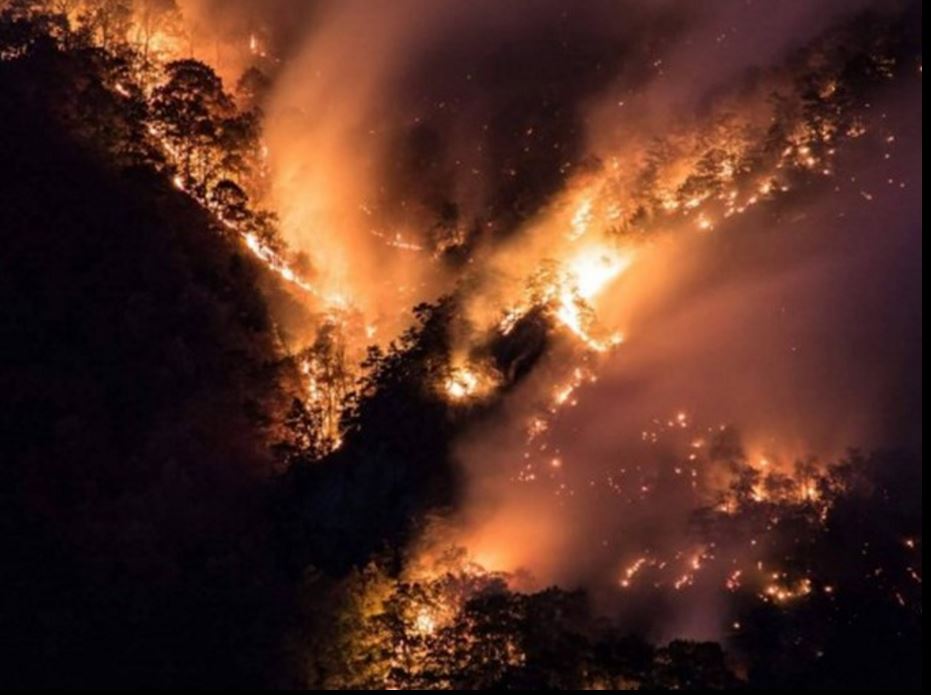Wildfires have charred thousands of acres across various forests in Western North Carolina since mid-October. As these wildfires continue to grow — along with residents' fears — firefighters are facing several challenges to get them under control.
The 2,883-acre Party Rock Fire near Lake Lure, as well as other fires in the Nantahala National Forest, have forced several mandatory evacuations of nearby homes as firefighters struggle to keep the flames from spreading.
Here's a list of questions and answers to provide information about these fires.
Q: What challenges are firefighters facing across the western part of the state?
A: "We're in a historically dry fall here," said Catherine Hibbard with the U.S. Forest Service. It's fifth-driest season in the past 104 years for Western North Carolina.
Dry weather and no rainfall combined with high wind gusts and low humidity levels have led to difficulties to contain the blaze. Additionally, dry leaves scatter the forest floor and firefighters are battling 3- to 4-foot flames on steep, rugged terrain.
Firefighters have had to work even harder to maintain containment lines with leaves and trees falling, which add fuel to the fire. And as firefighters have started to dig into the ground, there is no moisture, which normally provides some relief.
Steep slopes also provide a challenge because fire burns uphill faster than on flat ground. As fire begins to run uphill, firefighters must wait it out and catch it as it runs back down the mountain.
With wind gusts greater than 20 mph fire has quickly spread. Wind also has the potential to create spot fires outside of the containment lines that have been constructed causing the fire to spread. As wind gusts increase it also becomes unsafe for air support to lend extra aid with scout plans and additional water drops.
Limited access by roadways has made it harder for crews to get heavy equipment to remote locations as well as extremely tight roads filled with switchbacks.
Q: How do wildfires start and how do they spread?
A: Wildfires can either start from an environmental cause, typically a lightning strike, or from a human. The majority of a season’s fires can be attributed to human causes, such as a spark from machinery or carelessness in the form of unattended campfires, discarded cigarettes, uncontrolled yard waste burns to arson.
As wind gusts pick up, there is potential for embers to be blown across containment lines and spot fires to start potentially causing the fire to grow. Leaves falling off trees into containment lines can also cause the fire to spread.
Q: What efforts are used to contain the fire?
A: Crews have been building containment lines and dropping water from helicopters and aircraft.
"They have been fighting fire with fire by burning vegetation in between containment lines so there is nothing more to burn on the ground so it doesn’t burn as actively as it would have if there were no containment lines," Hibbard said.
Containment lines involve firefighters digging a deep hole or using bulldozers. Then they clear any fuels from the area, including leaves, branches and plants. With high winds and still-falling leaves, firefighters have had to be vigilant about keeping these lines clear so fuel does not cross spread over them.
Behind the scenes, a crew works on communications, logistics and operations, and includes fire behavior analysts and meteorologists.
Meteorologists determine the weather forecast, which analysts use to figure out what the fire activity will be and where the fire will spread. There are also people working to determine if any structures will be in the line of fire, and they pass along recommendations to county Emergency Management Services.
A communications or information team is set up to provide updates to media and the public.
Q: How much water can a helicopter carry for each dump? How many dumps can one do in a day?
A: Each helicopter used to drop retardant can carry a different amount of water. One helicopter on scene at the Party Rock Fire can carry 240 gallons of water.
Q: Where are crews getting water from to drop on the fires?
A: Agencies are using locally sourced water from lakes and rivers in the area, including Lake Lure and Lake Chatuge.
Q: What is needed to fully contain fires and keep them out?
A: Containment lines are the first step to keeping a fire from spreading. But to fully suppress a fire, rainfall and high humidity levels are key.
"We don't need just a little bit but a significant amount to make a big difference," said U.S. Forest Service fire behaviorist Gary Jarvis. "Until that happens we'll continue to have fires showing the same kind of behavior."
As humidity levels have remained incredibly low there's only been dry air, which has made it easier for fuels to catch fire.
Q: When officials say “the fire is 10 percent contained,” what does that really mean? And how do they determine the percentage?
A: "Containment is not always a science of saying I have lines wrapped all the way around (the fire)," said spokesperson Tom MacKenzie with the U.S. Forest Service. "It takes a number of factors into effect. It’s more than an art of a science."
When a fire is 10 percent contained it typically means that firefighters have anchor points and some strong established control lines in place where fuel can't burn anymore. It means that 10 percent of the total acreage has no more fuel to burn.
But several factors can contribute to calling a fire contained: winds, fire fuels and dry leaves continuing to fall.
"Experts are hesitate to say that fire is contained," MacKenzie said. "You may see a period of time where the fire is 85 percent contained and we’re monitoring it. It’s almost put to bed but there is a chance it could still pop back up with this leaf fall and additional smoldering snags."
Q: How many people are involved in fighting these fires? What resources have been called upon?
A: According to the U.S. Forest Service, on Thursday about 550 people were assisting with wildfires but that number continues to grow. At least 40 states and territories are involved including the U.S. Parks Service, U.S. Fish and Wildlife Commission, Bureau of Indian Affairs and not to mention several local agencies.
At the Party Rock Fire, which the N.C. Forest Service is leading, about 150 people were on site with another 150 from local agencies.
Both agencies are using various equipment from rakes, shovels, chainsaws and leaf blowers to bulldozers and air support. Several different types of helicopters and planes have been ordered for more than 20 fires burning across the region.
Gov. Pat McCrory declared a state of emergency for 25 counties Thursday, which means that he can pull resources from the National Guard to help assist with fires.
Q: What is the air quality forecast the area and what does it mean for residents/visitors?
A: According to the North Carolina Air Quality Forecast Center, several western counties are experiencing Code Orange or Code Red air quality because of smoke from numerous wildfires. When air quality reaches Code Orange or Code Red – the worst marker for air quality – people need to lower their outdoor exposure, said Tom Mather with the Air Quality Center.
“We recommend people be aware of their surroundings,” Mather said. “If you very visibly see smoke, that’s not good. When you see smoke, you should minimize your time outdoors." This is particularly important for children and the elderly, and those sensitive to air quality, such as people with asthma and respiratory problems.
In the four farthest western counties of the state, where the bulk of fires are burning, Friday's forecast was listed as Code Red, according to the Air Quality Center.
Smoky conditions were expected to remain in areas near wildfires Friday, according to the Air Quality Center. Areas very close to and immediately downwind of any wildfires may have even worse smoke impacts. For the rest of the state, the front will reinforce the Green/Good air quality away from the smoke.
Wildfires will likely burn over the weekend and will continue producing poor air quality. Winds will take smoke generally southward on Saturday, with the worst impacts mainly south/southwest of Bryson City, Hendersonville, and Morganton. As winds become light Saturday night and Sunday, smoke is expected to spread over a greater area, including the Asheville and possibly into the Hickory area.
For wildfire updates and evacuation information visit the Incident Information System.
Information provided by the N.C. Forest Service and U.S. Forest Service.


